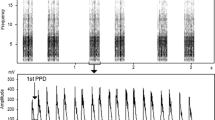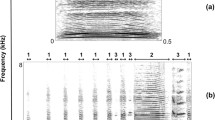Abstract
The questions of individuality and stability of cues to identity in vocal signals are of considerable importance from theoretical and conservation perspectives. While individuality in alarm calls has been reported for many sciurids, it is not well-documented that the vocal identity encoded in the alarm calls is stable between different encounters with predators. Previous studies of two obligate hibernating rodents, speckled ground squirrels Spermophilus suslicus, and yellow ground squirrels Spermophilus fulvus demonstrated that, after hibernation, most individuals could not be identified reliably by their alarm calls. Moreover, in most speckled ground squirrels, individual patterns of alarm calls changed progressively over as little as 2 weeks. However, these previous data have been obtained using the collection of alarm calls from trapped animals. Here, we examined ten free-ranging dye-marked yellow ground squirrels to determine whether their alarm calls retain the cues to individuality between two encounters of surrogate predators (humans), separated on average by 3 days. Discriminant function analysis showed that the alarm calls of individual yellow ground squirrels were very similar within a recording session, providing very high individual distinctiveness. However, in six of the ten animals, the alarm calls were unstable between recording sessions. Also, we examined ten dye-marked individuals for consistency of acoustic characteristics of their alarm calls between the encounters of humans, differing in techniques of call collection, from free-ranging vs trapped animals. We found differences only in two variables, both related to sound degradation in the environment. Data are discussed in relation to hypotheses explaining the adaptive utility of acoustic individuality in alarm calls.



Similar content being viewed by others
References
Balph DM, Balph DF (1966) Sound communication of Uinta ground squirrel. J Mammal 47:440–450
Blumstein DT (2007) The evolution of alarm communication in rodents: structure, function, and the puzzle of apparently altruistic calling in rodents. In: Wolff JO, Sherman PW (eds) Rodent societies. U Chicago Press, Chicago, pp 317–327
Blumstein DT, Daniel JC (2004) Yellow-bellied marmots discriminate among the alarm calls of individuals and are more responsive to the calls from juveniles. Anim Behav 68:1257–1265
Blumstein DT, Munos O (2005) Individual, age and sex-specific information is contained in yellow-bellied marmot alarm calls. Anim Behav 69:353–361
Blumstein DT, Verneyre L, Daniel JC (2004) Reliability and the adaptive utility of discrimination among alarm callers. Proc R Soc B 271:1851–1857
Blumstein DT, Patton ML, Saltzman W (2006) Faecal glucocorticoid metabolites and alarm calling in free-living yellow-bellied marmots. Biol Lett 2:29–32
Bokshtein FM, Kucheruk NV, Tupikova NV (1989) The use of territory and the interrelationships in the yellow ground squirrels (Citellus fulvus Licht, 1823). Russ J Ecol 20(5):45–50
Cheney DL, Seyfarth RM (1988) Assessment of meaning and the detection of unreliable signals in vervet monkeys. Anim Behav 36:477–486
Digweed SM, Rendall D (2009a) Predator-associated vocalizations in North American red squirrels, Tamiasciurus hudsonicus: are alarm calls predator specific? Anim Behav 78:1135–1144
Digweed SM, Rendall D (2009b) Predator-associated vocalizations in North American red squirrels (Tamiasciurus hudsonicus): to whom are alarm calls addressed and how do they function? Ethology 115:1190–1199
Efimov VI (2005) Yellow ground squirrel (Spermophilus fulvus Lichtenstein, 1823). In: Kucheruk VV, Khlyap LA (eds) Lagomorpha and rodents of the Middle Asia’s deserts. GEOS, Moscow, pp 40–65
Ford JKB (1991) Vocal traditions among resident killer whales (Orcinus orca) in coastal waters of British Columbia. Can J Zool 69:1454–1483
Grava T, Mathevon N, Place E, Balluet P (2008) Individual acoustic monitoring of the European eagle owl Bubo bubo. Ibis 150:279–287
Hanson MT, Coss RG (2001) Age differences in the response of California ground squirrels (Spermophilus beecheyi) to conspecific alarm calls. Ethology 107:259–275
Hare JF (1998) Juvenile Richardson’s ground squirrels, Spermophilus richardsonii, discriminate among individual alarm callers. Anim Behav 55:451–460
Hare JF, Atkins BA (2001) The squirrel that cried wolf: reliability detection by juvenile Richardson’s ground squirrels (Spermophilus richardsonii). Behav Ecol Sociobiol 51:108–112
Hasson O (1991) Pursuit-deterrent signals: communication between prey and predators. Trends Ecol and Evol 6:325–329
Ismagilov MI (1969) Yellow ground squirrel—Citellus fulvus. In: Sludskiy AA (ed) Mammals of Kazakhstan, v 1, rodents (marmots and ground squirrels). Nauka, Alma-Ata, pp 120–159
Jones BS, Harris DHR, Catchpole CK (1993) The stability of the vocal signature in phee calls of the common marmoset Callithrix jacchus. Am J Primatol 31:67–75
Klenova AV, Volodin IA, Volodina EV (2008) Duet structure provides information about pair identity in the red-crowned crane (Grus japonensis). J Ethol 26:317–325
Klenova AV, Volodin IA, Volodina EV (2009) Examination of pair-duet stability to promote long-term monitoring of the endangered red-crowned crane (Grus japonensis). J Ethol 27:401–406
Koeppl JW, Hoffmann RS, Nadler CF (1978) Pattern analysis of acoustical behavior in four species of ground squirrels. J Mammal 59:677–696
Koshev YS (2008) Distribution and status of the European ground squirrel (Spermophilus citellus) in Bulgaria. Lynx (Praha), ns 39:251–261
Koshev Y, Pandourski I (2008) Structure and variability of alarm calls of European ground squirrel (Rodentia: Spermophilus citellus L. 1766) from West Bulgaria. Acta zoologica Bulgarica 60:99–105
Leger WD, Berney-Key SD, Sherman PW (1984) Vocalizations of Belding`s ground squirrels (Spermophilus beldingi). Anim Behav 32:753–764
Lengagne T (2001) Temporal stability in the individual features in the calls of eagle owls (Bubo bubo). Behaviour 138:1407–1419
Mateju J, Nova P, Uhlikova J, Hulova S, Cepakova E (2008) Distribution of the European ground squirrel (Spermophilus citellus) in the Czech Republic in 2002–2008. Lynx (Praha), ns 39:277–294
Matrosova VA, Volodin IA, Volodina EV, Babitsky AF (2007) Pups crying bass: vocal adaptation for avoidance of age-dependent predation risk in ground squirrels? Behav Ecol Sociobiol 62:181–191
Matrosova VA, Volodin IA, Volodina EV (2008) Does kinship affect the alarm call structure in the yellow ground squirrel Spermophilus fulvus? Lynx (Praha) n s 39:295–303
Matrosova VA, Volodin IA, Volodina EV (2009) Short-term and long-term individuality in speckled ground squirrel alarm calls. J Mammal 90:158–166
Matrosova VA, Volodin IA, Volodina EV, Vasilieva NA, Kochetkova AA (2010) Between-year stability of individual alarm calls in the yellow ground squirrel Spermophilus fulvus. J Mammal 91(3) in press
McCowan B, Hooper SL (2002) Individual acoustic variation in Belding’s ground squirrel alarm chirps in the High Sierra Nevada. J Acoust Soc Am 111:1157–1160
Nikol’skii AA (1979) Species specificity of alarm call in sousliks (Citellus, Sciuridae) of Eurasia. Zoologicheskii Zhurnal 58:1183–1194
Nikol’skii AA, Suchanova MV (1994) Individual variability of alarm call in steppe marmot (Marmota bobac Mull., 1776). In: Rumiantsev VY (ed) Actual problems of marmots investigation. ABF Publishing House, Moscow, pp 169–181
Puglisi L, Adamo C (2004) Discrimination of individual voices in male great bitterns (Botaurus stellaris) in Italy. Auk 121:541–547
Rendell L, Whitehead H (2003) Vocal clans in sperm whales (Physeter macrocephalus). Proc R Soc B 270:225–231
Robinson SR (1981) Alarm communication in Belding`s ground squirrels. Z Tierpsychol 56:150–168
Rukstalis M, Fite JE, French JA (2003) Social change affects vocal structure in a callitrichid primate (Callitrix kuhlii). Ethology 109:327–340
Sayigh LS, Tyack PL, Wells RS, Scott MD (1990) Signature whistles of free-ranging bottlenose dolphins Tursiops truncatus: stability and mother-offspring comparisons. Behav Ecol Sociobiol 26:247–260
Schneiderová I, Policht R (2010) Alarm calls of the European ground squirrel Spermophilus citellus and the Taurus ground squirrel S. taurensis encode information about caller identity. Bioacoustics 19(3) in press
Shekarova ON, Neronov VV, Savinetskaya LE (2008) Speckled ground squirrel (Spermophilus suslicus): current distribution, population dynamics and conservation. Lynx (Praha) ns 39:317–322
Sherman PW (1977) Nepotism and the evolution of alarm calls. Science 197:1246–1253
Sherman PW (1985) Alarm calls of Belding’s ground squirrels to aerial predators: nepotism or self-preservation? Behav Ecol Sociobiol 17:313–323
Sloan JL, Hare JF (2006) Adult Richardson’s ground squirrels (Spermophilus richardsonii) ignore rate changes in juvenile alarm calls: age-differential response urgency perception? Ethology 112:896–902
Sloan JL, Hare JF (2008) The more the scarier: adult Richardson’s ground squirrels (Spermophilus richardsonii) assess response urgency via the number of alarm signalers. Ethology 114:436–443
Slobodchikoff CN, Kiriazis J, Fischer C, Creef E (1991) Semantic information distinguishing individual predators in the alarm calls of Gunnison’s prairie dogs. Anim Behav 42:713–719
Snowdon CT, Elowson AM (1999) Pygmy marmosets modify call structure when paired. Ethology 105:893–908
Solow AR (1990) A randomization test for misclassification probability in discriminant analysis. Ecology 71:2379–2382
Terry AMR, Peake TM, McGregor PK (2005) The role of vocal individuality in conservation. Front Zool 2(10): doi:10.1186/1742-9994-2-10
Tripp TM, Otter KA (2006) Vocal individuality as a potential long-term monitoring tool for Western screech-owls, Megascops kennicottii. Can J Zool 84:744–753
Tyack PL (1997) Development and social functions of signature whistles in bottlenose dolphins, Tursiops truncatus. Bioacoustics 8:21–46
Vasilieva NA, Tchabovsky AV (2009) Relationships between social activity, date of emergence and body mass of juveniles in the long-teeth ground squirrel (Spermophilus fulvus, Rodentia, Sciuridae). Zoologicheskii Zhurnal 88:588–595
Vasilieva NA, Savinetskaya LE, Tchabovsky AV (2009) Large body size and short period of activity do not impede fast growth in the long-teeth ground squirrel (Spermophilus fulvus). Zoologicheskii Zhurnal 88:339–343
Volodin IA (2005) Individuality in the alarm call of the speckled suslik Spermophilus suslicus (Rodentia, Sciuridae). Zoologicheskii Zhurnal 84:228–235
Weary DM, Kramer DL (1995) Response of eastern chipmunks to conspecific alarm calls. Anim Behav 49:81–93
Woodland DJ, Jafaar Z, Knight ML (1980) The “pursuit deterrent” function of alarm signals. Amer Natur 115:748–753
Acknowledgements
We thank Prof. S.A. Shilova, Dr. A.V. Tchabovsky, L.E. Savinetskaya, and N.S. Vasiliev for help with data collection. We are sincerely grateful to Dr. A.A. Lisovsky and Dr. V.S. Lebedev for help with statistics and to the four anonymous reviewers for their detailed and encouraging comments and for the correction of English. We are sincerely grateful to Stephen Pollard for his courteous and most helpful corrections of writing and language at the final stage of the revision of the manuscript. During our work, we adhered to the “Guidelines for the treatment of animals in behavioral research and teaching” (Anim. Behav., 2006, 71:245–253) and to the laws of Russian Federation, the country where the research was conducted. This study was supported by the Russian Foundation for Basic Research grants 09-04-00416 (for V.M., I.V., and E.V) and 08-04-00507 (for N.V.), and Russian Science Support Foundation (for N.V).
Author information
Authors and Affiliations
Corresponding author
Electronic supplementary material
Below is the link to the electronic supplementary material.
Movie of a juvenile female yellow ground squirrel producing a few clusters of alarm calls toward a human. Black “collar” is a dye mark. (MPG 8748 kb)
Rights and permissions
About this article
Cite this article
Matrosova, V.A., Volodin, I.A., Volodina, E.V. et al. Stability of acoustic individuality in the alarm calls of wild yellow ground squirrels Spermophilus fulvus and contrasting calls from trapped and free-ranging callers. Naturwissenschaften 97, 707–715 (2010). https://doi.org/10.1007/s00114-010-0686-7
Received:
Revised:
Accepted:
Published:
Issue Date:
DOI: https://doi.org/10.1007/s00114-010-0686-7




